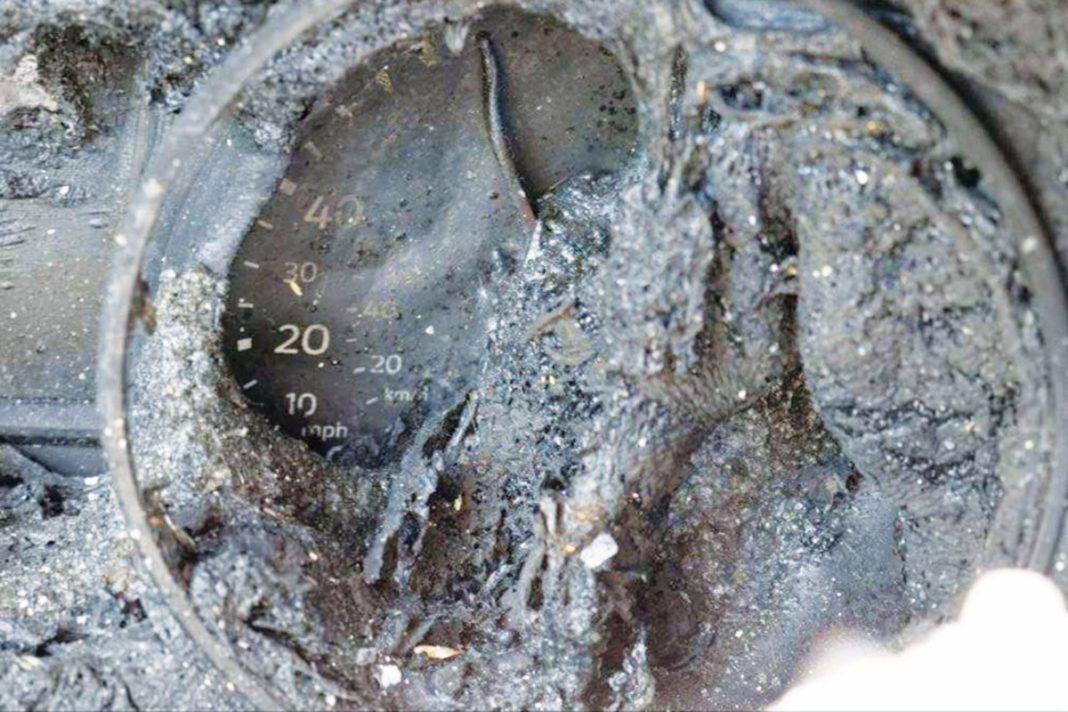Marin County District Attorney Lori Frugoli filed a misdemeanor vehicular manslaughter charge against a 17-year-old girl for the April auto accident in West Marin that resulted in the death of four teens.
Another young passenger had minor injuries, with the driver suffering serious burns, according to the California Highway Patrol.
The vehicular manslaughter charge, filed without gross negligence, followed the CHP’s release of a report by its accident investigative team that determined speeding caused the crash. While the investigation concluded that the then-16-year-old girl was driving 20 to 25 miles per hour over the 40 mph speed limit when the Volkswagen Tiguan went off San Geronimo Valley Drive in Woodacre, hit a tree and caught fire, the agency’s report raises some critical questions.
A key component to the report’s conclusions is how the CHP determined the sport utility vehicle’s speed at the time of the crash on the rural road. Because the vehicle’s data recorder, commonly referred to as “the black box,” sustained significant damage, it retained no data, the report said. The CHP’s investigation then focused on the “frozen” or stuck speedometer and tachometer needles, relying on those readings to peg the pre-impact vehicle speed at 60-65 miles per hour.
Yet the information that the CHP relied upon to reach this conclusion could be faulty, according to years-long research into using frozen speedometer readings for collision reconstruction. The CHP based their findings on a 2017 peer-reviewed paper, “Speedometers and Collision Reconstruction,” authored by Christopher H. Goddard and David Price and published by SAE International—formerly the Society of Automotive Engineers.
Citing the 2017 SAE International paper, the CHP concluded that the accident details and the type of speedometer in the VW Tiguan met with the criteria to provide “a level of confidence in accepting the residual readings.” Interestingly, this same technical paper also states that damaged instrument panels should not be considered reliable when determining speed.
The Pacific Sun obtained the 2017 paper and a subsequent 2022 SAE paper, “Validation of Frozen Speedometer Readings Against EDR Data,” by Christopher H. Goddard and Steve Anderson. EDR refers to “event data recorder,” the technical term for a black box.
The CHP’s investigation seemingly disregarded aspects of the 2017 paper—repeated in the 2022 study—that indicated the unreliability of the speedometer and tachometer readings with a damaged instrument panel. Some of the factors delineated in the papers include damage to the instrument cover or needle, as well as debris between the dial face and needle. The paper also cautioned that when a vehicle leaves the roadway before a collision, the readings could change.
Indeed, these factors were present in the 2019 VW Tiguan after the accident, according to the CHP’s report, which states the following: The instrument panel’s “front plastic had melted during the fire that occurred immediately after the crash.” The speedometer had a bent needle. The tachometer needle melted to the front plastic and was accidentally removed during the investigation. The background of the instrument panel’s gauges were covered in soot. And the vehicle left the road before hitting the tree.
The report gave no explanation for why the CHP used the damaged instruments in its crash analysis. Rather, it fixated on the reliability of frozen readings with the type of motors in the Tiguan’s instruments and that the gauge needles did not appear to have moved during the transport and removal of the instruments. The SAE’s two technical papers also focus on these points—but only after warning that instrument damage throws out the reliability of frozen instrument readings.
Photos in the CHP report show the blackened, crumpled remains of the SUV and close-up shots of the damaged instruments. One picture shows the significant right bend in the speedometer needle, which ultimately points to the 65-mph mark. Another shows text over a photo indicating the missing tachometer needle was stuck between 3,000 to 3,250 RPMs before it was inadvertently removed.
Investigators also used a scientific equation involving the tachometer reading to ascertain the SUV’s speed. The result supported the agency’s conclusion that the vehicle reached 60-65 mph before “immediate power loss” at the time of the impact.
“The analysis indicates the most likely scenario was that the VW Tiguan was in 5th gear at the time the vehicle lost power, and the tach was stuck in place. This analysis shows that the speed on the speedometer was consistent with what the engine was able to produce at the displayed RPM range,” the report stated.
But the calculations and analyses never consider the damage to the instruments, including the tachometer needle melting to its plastic cover or the bent speedometer. The CHP report also rejected the surviving passenger’s statement that a car had veered into the Tiguan’s lane, and the teen driver swerved to avoid it.
These points may surface in the upcoming months as the court case moves forward. The first proceeding took place in juvenile court on Oct. 22.
The youth sat beside her attorney and parents as the charges were read by Marin County Superior Court Judge James Chou. A misdemeanor vehicular manslaughter without gross negligence charge carries a maximum penalty of up to a year in jail.
The DA also filed two infractions—traffic tickets—against the girl, one for speeding and the other for violating her provisional license by transporting passengers under the age 20 without a parent or licensed driver over 25 in the car.
Both deputy district attorney Cassandra Edwards and defense attorney Charles Dresow requested that the judge close the court proceedings to the public because the defendant is a juvenile. The harm to the minors involved outweighs the public’s interest due to the gravity of the case, argued Edwards.
“We’ll be discussing the deaths of four young women,” Dresow said.
The judge was not swayed. Chou cited a juvenile statute that keeps the court proceedings open to the public for certain offenses, including manslaughter. However, he stated that if the attorneys could cite applicable case law, he is open to being persuaded to close the courtroom.
“The District Attorney is in the process of petitioning the Juvenile Court to reconsider its position,” DA Frugoli said in a statement.
The fatal crash occurred on April 18 in the early evening when the teen was driving with her five friends to a sleepover in Woodacre. The six girls, ranging in age at the time from 14 to 16, attended Archie Williams High School in San Anselmo.
Sienna Katz, 15; Ada Kepley, 15; Olive Koren, 14; and Josalynn Osborn, 15, died in the accident.
The defendant is expected to enter a plea during the next court date on Dec. 3.









CHP investigation based on experience should be able to determine speed based on how damaged the car was. She was inexperienced and unfamiliar with how a car handles differently loaded with 500 lbs of passengers. The fuel pressure runs 3000 psi and spraying when broken open from impact are instantly flammable from engine’s exhaust of 400-500 degrees. It was a horrible tragedy that unfortunately should never have happened. Restricted driving is in place for exactly this reason
It appears Nikki Silverstein is grasping at straws in order to form a highly technical defense for the accused. Putting aside the questionable instrument settings, there is enough incontrovertible conventional physical evidence to warrant a trial.
The speedometer and tach notwithstanding, the tangled mess and lack of skid marks are a very clear indicator of excessive speed. Much ado about a melted speedo.
No blood test was released by the driver, the mother of the driver knew driver would be illegally transporting these children and the destination house parent knew as well.